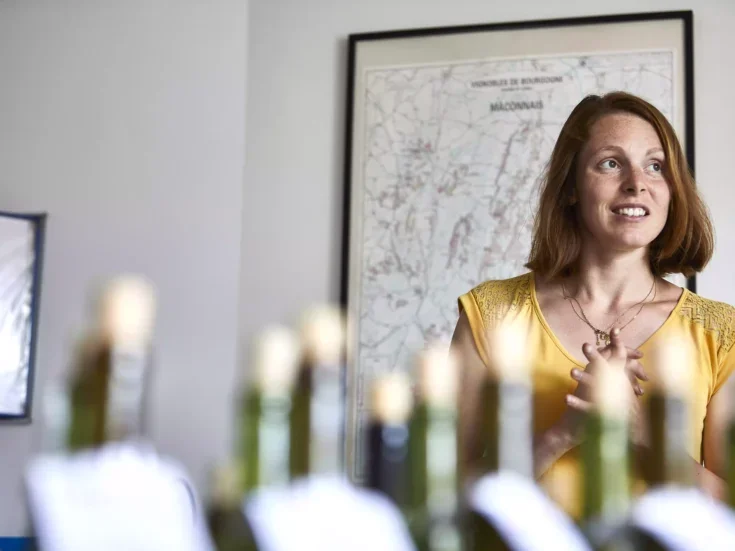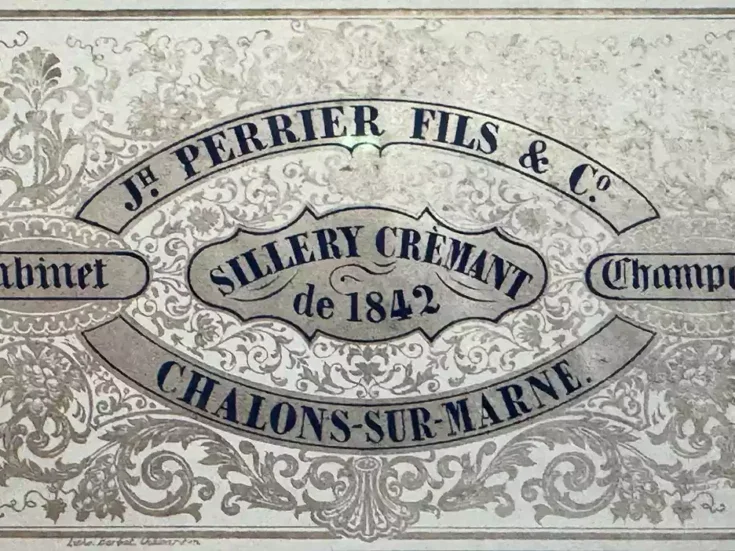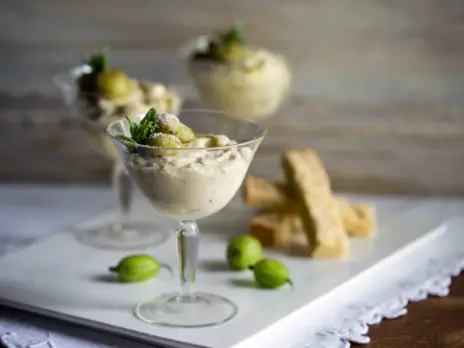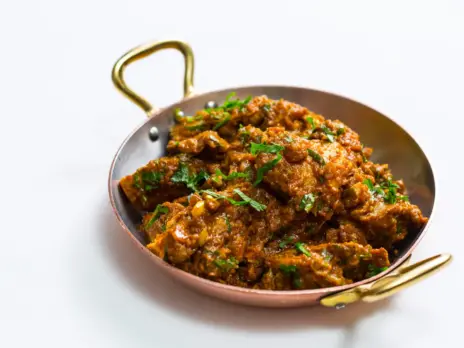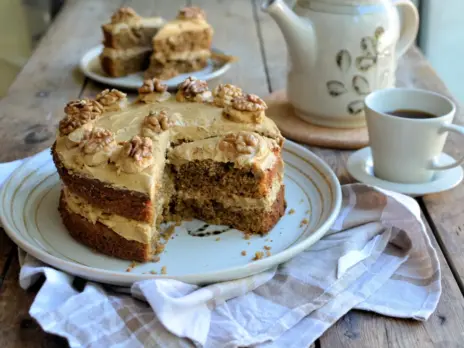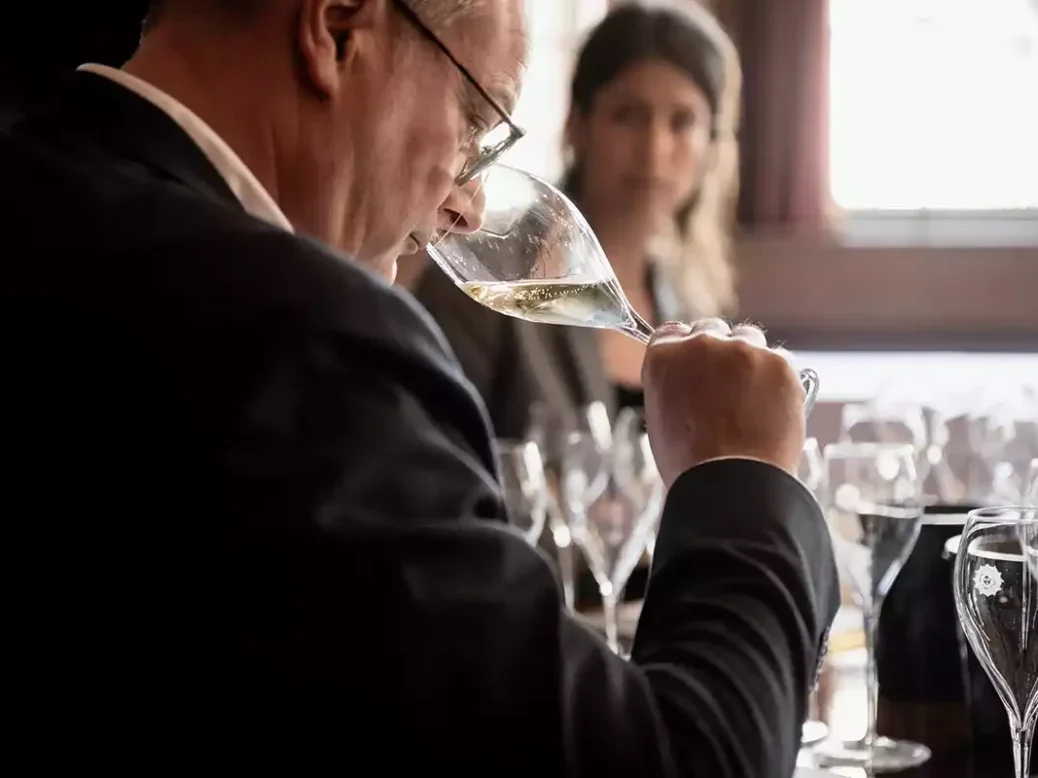
A tasting of any new release of Laurent-Perrier Grand Siècle is always keenly anticipated, but there was no suggestion that a new iteration (Laurent-Perrier’s word) was to be unveiled at the event held in the boardroom of The Vintners Hall in London at the end of April. Indeed, the invitation—from, tantalizingly, the largely unknown new cellar master (of whom, more in a moment)—was billed not as a tasting but a masterclass.
It turned out to be a (mostly) vertical tasting of eight Grands Siècles in seven iterations. Seven because there was a horizontal element in that No.24 was shown in both bottle and magnum. Magnums of Grand Siècle are aged for three years longer on lees and released later than bottles—often at the same time as the bottle two iterations later—
for example, No.25 in bottle released with No.23 in magnum in March 2022 (see WFW 76, pp.58–59).
What made this first-of-its-kind tasting all the more unusual was that the bottles and magnums were not disgorged specially in anticipation of the event. They were disgorgements currently available in the UK, with the exception of Les Réserves No.20, the magnum of which was disgorged in early February and would normally have been kept for at least another six months before being shipped. There is an earlier disgorgement of Les Réserves No.20 on the market, all iterations being disgorged successively—on average four or five for each iteration.
Laurent-Perrier Grand Siècle: A distinctive prestige cuvée
The object of the tasting was to show the small group of assembled specialist writers the available range of what is a very grand Champagne that still flies slightly under the radar—certainly in comparison with the likes of Dom Pérignon, Cristal, and Krug, its main prestige cuvée competitors when it was launched in the 1950s.
It is curious that it should be so, considering that it’s the creation of one of Champagne’s best-known, most astute, innovative, and energetic ambassadors, Bernard de Nonancourt, but somehow it has not always been communicated, or other houses have been better at blowing their trumpets. As newly appointed chef de cave Olivier Vigneron put it, in answer to a question about whether he was making or planning any changes, “We always try to innovate; we try to improve all the time, but we are terrible about communicating it.”
From this you glean that Olivier Vigneron (the name is a genuine aptronym) is not overly formal or devoid of a sense of humor. That said, it is immediately apparent that he is not a cellar master in the animated, English-speaking, ambassadorial mold that has increasingly become the norm. He conducted the tasting in French, his words translated by Constance Delaire, who joined Laurent-Perrier in the role of a communication-focused enologist in 2023.
He is also, or was when he was appointed last year, something of an unknown, at least outside the house where he has worked since 2004 and outside Champagne’s inner circles. And he was passed over—perhaps he chose to be—for the position of chef de cave not once but twice in the previous four years, two successive new cellar masters having each departed after barely a year. This left longtime incumbent Michel Fauconnet still at the helm after, it seems, never really handing over to the two incoming cellar masters.
Will he—has he—handed over to Olivier Vigneron? The answer given is that Michel is partly retired, but “he is Laurent-Perrier,” he is part of the house. The more important point is probably Olivier’s assertion that Michel trusts him. Olivier worked for him for two decades and covered every area including purchases. So, it sounds hopeful.
Meanwhile, what Olivier is more comfortable talking about is Grand Siècle, Bernard de Nonancourt’s pioneering Multi-Vintage cuvée, the intent of which was to recreate the perfect year every year—a Champagne that would express the purity of the primary aromas and the aromatic complexity of secondary and tertiary aromas all in one, every time.
As the vagaries of Champagne’s weather meant that this was not possible in each successive year (and still isn’t), Le Grand Bernard, as he was known, came up with the idea of blending three complementary declared vintages and of using more Chardonnay (54–60%) than Pinot Noir, sourcing the grapes from 11 grands crus (though not always all of them) and aging the wine for a minimum of ten years on lees. For magnums, it is more than ten years, and for the even rarer Les Réserves, introduced more recently and only ever in magnums, it’s more than 20 years.
The 11 grands crus are, for the Chardonnay component, Avize, Cramant, Le Mesnil-sur-Oger, Oger, and Chouilly, the most often omitted. For Pinot Noir, they are Ambonnay, Bouzy, Mailly, Tours-sur-Marne, Verzy, and, most often omitted, Verzenay. A 12th, Louvois Pinot Noir, has been used, but not since No.17.
Other features are stainless steel (no oak), malolactic fermentation, a low dosage (7g/l or, in the case of Les Reserves, 6g/l), and the signature, maturation-slowing, long slender neck of both the bottle and the magnum. For Olivier, this shape is “really important for evolution—more important than the disgorgement date.” He stresses also the importance of Chardonnay as the colonne vertebrale (backbone) of precision at every stage from the vineyards onward, of being a wine house, as well as an international Champagne house, and of creating a Champagne that combines youthful vitality with tertiary complexity. Having seen 21 vintages at Laurent-Perrier, he has the advantage of having been involved with every iteration we are about to taste, except the two Les Réserves, No.20 and No.17. Bernard de Nonancourt would, surely, approve.
Tasting
Laurent-Perrier Grand Siècle No.26 (65% 2012, 25% 2008, 10% 2007; 58% C, 42% PN; eight grands crus, Chouilly, Mailly, and Verzenay not included; disgorged February 19, 2024, after 10 years on lees; dosage 7g/l)
Medium-pale primrose, with a faint glimmer of green. There is an immediacy and ebullience to the nose, with waves of confit lemon, peach, mirabelle plum, sea spray, hazelnut butter, shortbread, and toast. The wine spreads across the palate with mouth-filling density, chalk-dust fine texture, and deep, toasted-nut sweetness. Then citrus zest and acidity close in, pulling tightly, almost bracingly—a reminder that Chardonnay has the upper hand in the blend. The balance is perfect, the flavor goes on and on. This is exhilarating and immensely satisfying to drink now but will develop gracefully for many years. | 97
Laurent-Perrier Grand Siècle No.25 (65% 2008, 25% 2007, 10% 2006; 60% C, 40% PN; nine grands crus, Chouilly and Verzenay not included; disgorged September 12, 2022, after 12 years on lees; dosage 7g/l)
A very similar color to No.26 but without the hint of green. Again, there’s an exciting immediacy, even flamboyancy, to the nose, but it’s more about the peach—fragrant white peach—than about the toast and nuts. There are notes of cantaloupe melon and tropical fruit, too, and characteristic candied lemon peel. Equally characteristically, the lemon asserts itself on the palate but is flattered there by acacia honey and peaches and cream underwritten by salted almond and hazelnut. Long, complex, and generous, with plenty of zing and zest, but not quite as spine-tingling as No.26 or the bottle I tasted in March 2022 that had been disgorged in the second quarter of 2021. Perhaps it’s just a phase. | 95–96
Laurent-Perrier Grand Siècle No.24 (60% 2007, 20% 2006, 20% 2004; 55% C, 45% PN; 11 grands crus; disgorged June 21, 2023, after 12 years on lees; dosage 7g/l)
Disgorged more recently than No.26 and No.25, and based on 2007, a year Olivier Vigneron describes as “very complicated,” this has a green glint and is slightly paler than both No.26 and No.25. It has a marked savory, umami character—a briny oyster-shell salinity that comes tantalizingly close to petrichor—and the fruit is sweet but intensely lemony, pure, and precise. The texture is beautiful, and a richer note of toasted nut and oatmeal emerges as the wine slowly, very slowly, swells on the palate. This is less exuberant and more mineral, savory, and acid-driven than No.26 or No.25, but it’s also very long (not that I have had a Grand Siècle that isn’t) and I think has more promise than one might imagine on the first taste. | 96
Laurent-Perrier Grand Siècle No.24 (magnum) (60% 2007, 20% 2006, 20% 2004; 55% C, 45% PN; 11 grands crus; disgorged June 20, 2024, after 15 years on lees; dosage 7g/l)
A slightly deeper color and a fresher, deeper nose than the bottle disgorged a year earlier. It’s altogether more aromatic, with a perfume of kumquat and lovely, toasted sweetness. The palate, too, feels deeper and more intense in every way, with incisive acidity and energy and a texture that is slightly richer and chalkier again. The kumquat is still there, joined by a ripple of lime sherbet, but the defining articulation is the salty, stony, minerality—even the pastry and biscuit notes are more savory than sweet. All in all, the impression is of a more tightly furled and younger wine. | 97
Laurent-Perrier Grand Siècle No.23 (magnum)
(65% 2006, 20% 2004, 15% 2002; 58% C, 42% PN; 11 grands crus; disgorged November 23, 2022 after 14 years on lees; dosage 7g/l)
Based on the warm 2006 vintage, the nose shows complex, umami, truffley tertiary notes and indulgent, sweet Chantilly cream. The palate is rounder, broader, and fleshier than No.24, especially the magnum. An enveloping, creamy texture and generous peach, glazed apple, almond pâtisserie, and buttery pastry are shot through with flecks of truffle. And just when you think you might lose yourself in its luxurious embrace you are woken by electric acidity—acidity that’s so well integrated that it isn’t obvious at first. | 96
Laurent-Perrier Grand Siècle No.22 (magnum)
(55% 2004, 30% 2002, 15% 1999; 55% C, 45% PN; nine grands crus, Chouilly and Verzenay not included; disgorged May 27, 2019, after 13 years on lees; dosage 7g/l)
Disgorged 40 months before any other wine in the tasting, No.22 is distinctive in that the principal component of the blend, 2004, makes up a markedly smaller proportion than the usual 65 or 60%. It’s a vintage that Olivier Vigneron likes very much (his first at Laurent-Perrier, as it happens), although, as many readers will know (see WFW 86, pp.166–71), it was initially underestimated because of its large volume and its misfortune to follow the universally acclaimed 2002. Describing 2004 as “truly different from other vintages,” Olivier says it brings freshness and aromatic purity, while a higher than usual proportion of the second vintage component, 2002, “brings aromatic expression,” as does the 1999. There is certainly a purity and graceful sweetness to this wine. Lifted, floral and honey-toned peach fruit comes in gentle tidal waves, with richer toasted brioche; textural depth is woven with acidity that is still vibrant but also “sweet” and refined. Beautifully articulated. | 97
Laurent-Perrier Grand Siècle Les Réserves No.20 (magnum) (60% 1999, 20% 1997, 20% 1996; 54% C, 46% PN; eight grands crus, Chouilly, Verzy, and Verzenay not included; disgorged February 4, 2025, after 20+ years on lees; dosage 6g/l)
Les Réserves No.20 is on the market, but not this disgorgement, which was done specially, less than three months before the tasting. The normal post-disgorgement waiting time is a minimum of six months, a period that Olivier Vigneron thinks is very important. Perhaps a little more time will bring further integration, but I loved the explosion of aroma and flavor—the spiciness of stem ginger and white pepper, the sweet leather, honey, umami notes and malty richness, the radiant orange and fresh hop notes. Richly detailed, honeyed, and creamy textured; crackling with acidity, energy, and salinity. Very long, flawlessly fresh, confident, and very persuasive. | 98+
Laurent-Perrier Grand Siècle Les Réserves No.17 (magnum)
(60% 1995, 20% 1993, 20% 1990; 55% C, 45% PN; ten grands crus, including Louvois Pinot Noir, which has not been used since; no Pinot from Verzy or Verzenay and no Chouilly Chardonnay; disgorged October 25, 2023, after 20+ years on lees; dosage 6g/l)
A slightly deeper shade of primrose than all the others, just hinting at yellow gold. The mousse is less vigorous and the nose a little restrained at first, but it opens up to release a plume of intense lemon-citrus fruit, golden toast and hazelnuts, wrapped with a lightly smoky edge. The palate is vinous, layered, and concentrated, with acidity that shimmers—glacial, pure, and lively. Still in its prime, it’s hard to believe that 60% of the grapes were picked 30 years ago (very nearly) and the rest came from even earlier harvests. | 98

